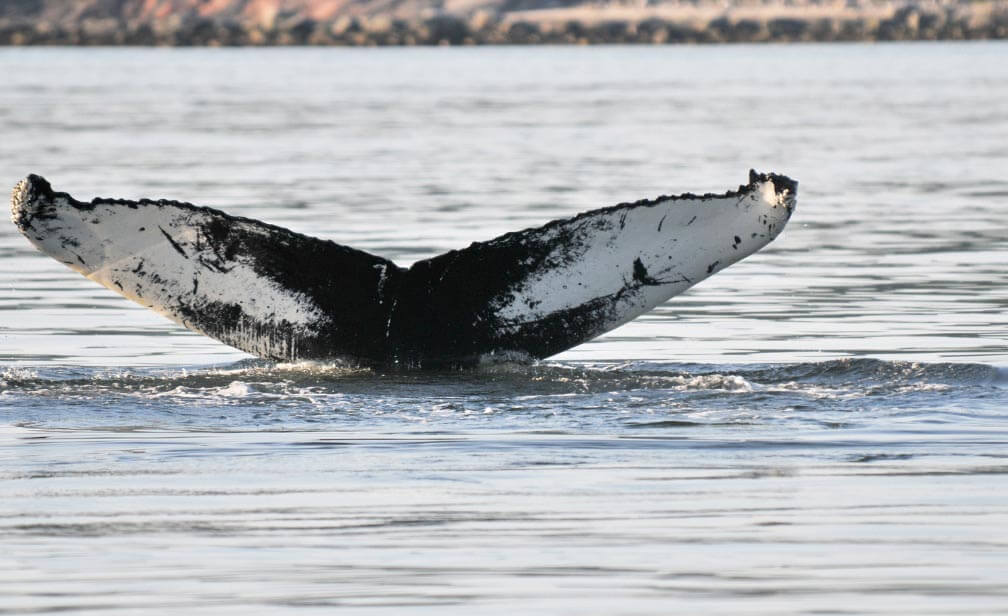Wednesday morning, just as the team from the Marine Mammal Interpretation Centre (CIMM) begins its workday, time stands still for a half hour. Everyone stares out to sea to observe an invasion of white backs in the mouth of the Saguenay. Numerous belugas are swimming in small, tight formations. The group intersects the ferry crossing route and then vanishes between the rocky cliffs that tower over the Fjord. Every summer is different and brings its lot of surprises, but some things seem to be practically set in stone. The return of belugas to the Saguenay Fjord, for example, is certainly synonymous with the start of the season.
Where do they go? Toward Baie Sainte-Marguerite, a place of great social importance for these animals, which are stalwart visitors to this bay between late June and mid-September. Researchers estimate that more than half of all St. Lawrence belugas, including two-thirds of all females, frequent the Saguenay during the course of the summer! To protect them, the bay is off-limits to boats between June 21 and September 21.
This week, white backs have therefore been observed all up and down the Saguenay, punctuating the dark surface of this deep, frigid river. Saturday morning, June 19, a resident of L’Anse-à Pierrot is delighted: “I can see belugas on both sides of the Fjord, in two small groups. There are white adults as well as little ones!” The following day, a large herd was reported near Pointe-Noire, a land-based observation site in Baie-Sainte-Catherine. On Monday, during a paddling trip near L’Anse-de-Roche, the kayak guide also spotted a group of belugas moving upstream in a hurry.
Mystery and wonder
Along the south shore of the St. Lawrence, it’s clearly not yet time for socializing and reproduction for certain belugas that are too busy relishing the schools of herring building up near the docks. Observers note the daily presence of white belugas, sometimes accompanied by smaller greys, around the wharves of Cacouna and Rivière-du-Loup. Additionally, we once again received word of the presence of a bewildering all-black toothed cetacean breaching off the coast of Cacouna. However, this mysterious visitor has yet to be identified, creating a great deal of excitement amongst the editorial staff.
An observer on holiday at Île aux Lièvres tries to photograph a large harbour seal lying on a rock. Its characteristic “banana” position amuses the vacationer: “Every evening at supper time, it was there on his favourite rock, doing its yoga exercises!” The fascination we have with marine mammals and their behaviour is another one of those immutable things that even time cannot erode. Friday morning, even GREMM’s scientific director Robert Michaud, despite the innumerable hours he has spent at sea, cannot contain his excitement upon seeing a minke whale: “There’s action in Les Bergeronnes… and a minke whale seems to be trying to take flight… 23 times! Each attempt unsuccessful and ending with a huge belly flop!”
Back on the job!
Out in the Gaspé, the captain of a whale-watching boat opines: “There’s no such thing as a typical season. It can change completely from one year to the next, it’s never the same.” Right now, it’s cetaceans galore.
“Tuesday morning while I was out doing my scouting from Cap-Bon-Ami, I was spoiled,” he points out. “In the span of 5 minutes, I tallied 20 spouts from humpbacks, and about 10 belonging to fin whales!” The next day, two fin whales came within 50 metres of the wharf. On Sunday, at the entrance to Gaspé Bay, he even claims to have spotted his first blue whale of the season!
Local observers are having a field day. “Yesterday, they were breaching everywhere! We even saw a minke whale and a humpback breach at the same time!” exclaims a captain. “There’s action!” confirms a resident of L’Anse-aux-Cousins. On Sunday, she counts at least 4 minke whales, 4 or 5 humpbacks and a few fin whales. But also grey and harbour seals “en masse!” Back from a hike in Forillon National Park, she shares her experience: “You can hear them blowing from the trail. It’s always impressive to be able to hear whales!”
René Roy, a collaborator from the Mingan Island Cetacean Study (MICS), has been noting many fairly young humpbacks off Cap Gaspé, as well as mother-calf pairs, but he has also spotted some “old acquaintances” such as Bolt (H102 ), Fleuret (H009) and Irisept (H492). Will any of these whales continue their course all the way to the Gulf or the Estuary? Known since 1997, Irisept is frequently seen in the Gulf but rarely in the Estuary, unlike Tic Tac Toe, for example. Each whale seems to have its own little habits and its favourite haunts.
And then there are those whose movements take us by surprise. The humpback whale H944, for example, observed last summer in the Saguenay-St. Lawrence Marine Park and still present in the Estuary on December 14 when most of its peers had left for the South, was photographed on June 18 in Maine. Some like routine, others not so much.
Where are the whales this week? Here's what our collaborators saw!
These observations give an idea of the presence of whales and do not represent the real distribution of whales in the St. Lawrence. Use them for fun!
Click on the whale or seal icons to discover the species, the number of individuals, additional informations or photos of the sighting. To enlarge the map, click on the icon in the upper right corner. The map works well on Chrome and Firefox, but not so well on Safari.
To display the list of sightings, click on the icon in the upper left corner.









